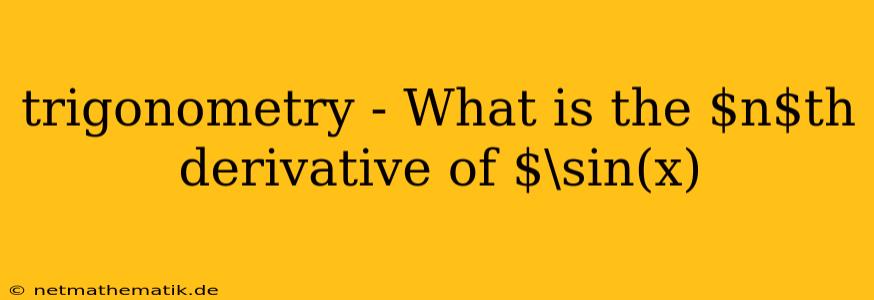Trigonometry, a fundamental branch of mathematics, plays a crucial role in various scientific fields, including physics, engineering, and astronomy. One intriguing aspect of trigonometry is the study of derivatives of trigonometric functions. Determining the $n$th derivative of $\sin(x)$ presents a fascinating challenge that unveils the cyclical nature of these functions. This article delves into the process of finding the $n$th derivative of $\sin(x)$, highlighting the patterns and relationships that emerge.
Understanding the First Few Derivatives
Before tackling the general case of the $n$th derivative, let's examine the first few derivatives of $\sin(x)$ to identify any recurring patterns.
-
First Derivative: The derivative of $\sin(x)$ is $\cos(x)$.
-
Second Derivative: The derivative of $\cos(x)$ is $-\sin(x)$.
-
Third Derivative: The derivative of $-\sin(x)$ is $-\cos(x)$.
-
Fourth Derivative: The derivative of $-\cos(x)$ is $\sin(x)$.
Notice that the fourth derivative of $\sin(x)$ returns to the original function, $\sin(x)$. This cyclic behavior suggests a pattern that we can exploit to determine the $n$th derivative.
Identifying the Pattern and Generalization
From the first few derivatives, we observe that the derivatives of $\sin(x)$ follow a cycle of four functions: $\sin(x)$, $\cos(x)$, $-\sin(x)$, and $-\cos(x)$. This cycle repeats indefinitely as we continue taking higher-order derivatives.
To express this pattern mathematically, we can represent the $n$th derivative of $\sin(x)$ as follows:
$\frac{d^n}{dx^n} \sin(x) = \begin{cases} \sin(x) & \text{if } n \equiv 0 \pmod{4} \ \cos(x) & \text{if } n \equiv 1 \pmod{4} \ -\sin(x) & \text{if } n \equiv 2 \pmod{4} \ -\cos(x) & \text{if } n \equiv 3 \pmod{4} \end{cases}$
This formula elegantly captures the cyclical nature of the derivatives of $\sin(x)$. The notation $n \equiv a \pmod{4}$ means that $n$ leaves a remainder of $a$ when divided by 4.
Proof by Induction
We can formally prove this formula using mathematical induction.
Base Case:
For $n = 0$, the formula holds true since the zeroth derivative of $\sin(x)$ is simply $\sin(x)$.
Inductive Step:
Assume that the formula holds for some integer $k \geq 0$. That is,
$\frac{d^k}{dx^k} \sin(x) = \begin{cases} \sin(x) & \text{if } k \equiv 0 \pmod{4} \ \cos(x) & \text{if } k \equiv 1 \pmod{4} \ -\sin(x) & \text{if } k \equiv 2 \pmod{4} \ -\cos(x) & \text{if } k \equiv 3 \pmod{4} \end{cases}$
We need to show that the formula also holds for $n = k + 1$.
-
Case 1: If $k \equiv 0 \pmod{4}$, then $k + 1 \equiv 1 \pmod{4}$. Using the inductive hypothesis, the $k$th derivative of $\sin(x)$ is $\sin(x)$. Taking the derivative one more time, we get $\cos(x)$, which agrees with the formula for $k+1$.
-
Case 2: If $k \equiv 1 \pmod{4}$, then $k + 1 \equiv 2 \pmod{4}$. The inductive hypothesis gives us $\cos(x)$ as the $k$th derivative. Differentiating again, we get $-\sin(x)$, consistent with the formula for $k+1$.
-
Case 3: If $k \equiv 2 \pmod{4}$, then $k + 1 \equiv 3 \pmod{4}$. The $k$th derivative is $-\sin(x)$ by the inductive hypothesis. Differentiating once more, we obtain $-\cos(x)$, matching the formula for $k+1$.
-
Case 4: If $k \equiv 3 \pmod{4}$, then $k + 1 \equiv 0 \pmod{4}$. The inductive hypothesis gives us $-\cos(x)$ for the $k$th derivative. Taking the derivative again, we get $\sin(x)$, which is in line with the formula for $k+1$.
Since the formula holds for $k+1$ whenever it holds for $k$, it holds for all $n \geq 0$ by the principle of mathematical induction.
Applications
The knowledge of the $n$th derivative of $\sin(x)$ finds applications in various mathematical and scientific contexts:
-
Taylor Series Expansions: The $n$th derivative plays a crucial role in deriving the Taylor series expansion of $\sin(x)$. This expansion allows us to approximate the value of $\sin(x)$ using polynomials, which is particularly useful in numerical analysis and computer programming.
-
Differential Equations: The derivative of $\sin(x)$ appears in many differential equations that describe physical phenomena, such as oscillations, waves, and alternating currents. Understanding the pattern of derivatives allows us to solve these equations more efficiently.
-
Calculus and Analysis: The concept of derivatives of trigonometric functions serves as a foundational element in calculus and analysis. It provides a framework for understanding the behavior of functions and their rates of change, which is crucial for solving problems in optimization, integration, and other areas of mathematics.
Conclusion
Finding the $n$th derivative of $\sin(x)$ reveals the fascinating cyclical nature of this trigonometric function. By recognizing the pattern and using mathematical induction, we can derive a general formula that elegantly captures the behavior of higher-order derivatives. This knowledge finds applications in various fields, highlighting the importance of trigonometry in mathematics and science.
